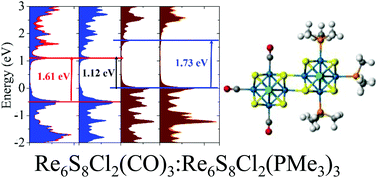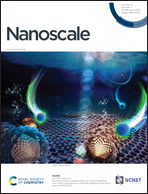Superatomic molecules with internal electric fields for light harvesting†
Abstract
Traditional p–n junctions used for photovoltaics require an interface where a light induced electron–hole pair is separated by an electric field. Developing alternative strategies for forming strong internal electric fields for electron–hole pair separation offers the possibility for better performance. We demonstrate that fusing two superatomic clusters with donor/acceptor ligands on opposite sides of the cluster leads to such a strong internal electric field. In two fused metal–chalcogenide Re6S8Cl2(L)4 clusters with donor PMe3 ligands and acceptor CO ligands on the opposite sides of the fused clusters, the electronic levels undergo shifts analogous to band bending in traditional p–n junctions. The fused cluster has a large dipole moment, and an optical spectrum that strongly absorbs excitation above the HOMO–LUMO gap of the fused clusters, but is optically very weak for the lowest energy excitation that can lead to electron–hole pair recombination. This is because the electron is localized on the CO portion of the fused cluster, while the electron–hole pair is localized on the PMe3 side of the cluster. It is shown that the electronic states localized on each side of the cluster can be aligned/misaligned by applying a voltage in different directions, offering diode like characteristics.



 Please wait while we load your content...
Please wait while we load your content...